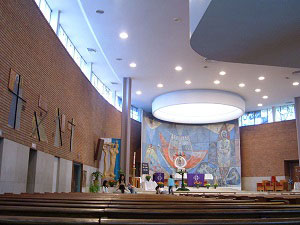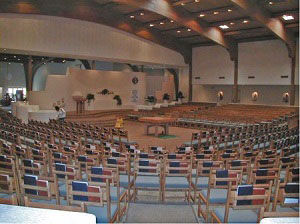

|
| Musical Musings: Liturgy |
|
|
Fifty Years of Effete and Infertile Liturgical Culture Is EnoughThis article is reprinted from the online edition of Crisis Magazine, with the kind permission of John M. Vella, Editor.
I rolled the dice and landed at the "hotel" in Marvin Gardens. When I entered, the priest was stationed in the vestibule, ready to greet people on their way in — and perhaps offer to carry their luggage. I do not want to be greeted on my way in. I want to prepare and to pray, which is never easy for me because my thoughts wander. The inside of the church resembled the lobby of a three-star hotel trying to be a four-star. Its shape was a flattened ellipse, with its entry on the broad side, so that there was more room from left to right than from back to front. There was no sacristy [sanctuary]. Instead there was a large teardrop-shaped peninsula, like the Peloponnese, extending from the front and far into where the people would be seated. This Peloponnese was raised a few feet from the level of the front pews, and in the middle of the teardrop, sort of near Sparta, stood the altar, with the priest's chair stationed ten feet behind it. At Athens, to the right, stood a lectern (which served as the pulpit) facing neither the people in front nor the priest, but maybe something beyond them in the distance, like Crete. A church lady stood at the lectern and began to "announce things," including the name of the priest. She also instructed us that at Our Lady of Perpetual Motion, we do not kneel after Communion — might this be lest we show undue honor to the Lord? We were to remain standing until Father was seated, in order to show our unity with those whose order-numbers were still to be called. At Thomas More, I am teaching a course in poetry and liturgy, called Coram Angelis — In the Presence of the Angels. We have been reading Monsignor Ronald Knox's series of sermons for the schoolgirls at Aldenham, called The Mass in Slow Motion. It is a missive from another universe, like a letter you might find intact under the rubble of a bombed-out city. It is quite charming. Monsignor Knox describes his thoughts and feelings in a tone that ranges from the jocular to the quietly profound, as he moves from one part of the Mass to the next. He gives no thought to being special. When he gets to the place in the canon where he is to insert "Pius" for the pope's N. and "Moriarty" for the bishop's N., he notes that the N's suggest that he the priest is eminently replaceable by somebody else; he is just an instrument that God is using for his purposes. His simile for it is a pattern for humility: You know how they put down little reflectors of red glass at the corner of the road where there is a cross-roads, or where some sharp turn makes it dangerous; and as your car comes up at night, the light of the headlamps is caught by these and reflected back? Well, the priest ought to think of himself as one little piece of red glass; the moment when he consecrates, when he offers sacrifice, is the moment in which the prayer of the universal Church is caught up and reflected in him. Only for a moment; then he goes back to being a dull, ordinary piece of glass again. There is no such sense of self-effacement at Our Lady of Bustle and Business. We name ourselves, we hear the name of the priest, we hear the names of the servers, and I believe we heard the name of the Church Lady. Then — may God help us — we begin to sing. Or, rather, the Church Lady, a coloratura soprano, sings into the Athenian microphone, and the congregation mumbles along.
It would be hard to find the tabernacle in the lobby of the Sheraton, and it was hard to find it in Our Lady Seat of Wellness. I never located it. There was a large crucifix, and Stations of the Cross, sufficiently distant and small so as not to disrupt the feeling of blankness that the "lobby" engendered. This was unfortunate, because I was there with two men of the Eastern Orthodox Church and they were looking here and there for something, i.e., something that would suggest the presence of Christ in the Eucharist. I did defy the directive to remain standing after Communion, but it did me no good. The Athenian singer broke into a second song, one not listed on the board, and it prevailed against my attempt to pray a customary Litany of the Sacred Heart. "Heart of Jesus, substantially united to…" eagle's wings or something. Sacrosanctum Concilium says that silence should be respected, but there was no silence. How could there be? We are to be silent before the holy, but at Saint Secular of Southern California there was no sense of the holy. "There's nothing more splendid in the Mass," says Monsignor Knox of the moment when "the priest bends down and drops his voice to a low murmur: Sanctus, sanctus, sanctus, Dominus Deus Sabaoth." It's as if he "has reached the very door of the heavenly temple, and takes one look through the keyhole. And he says 'SSSH! I've seen it! The glory of God, that fills earth and Heaven, shining in front of me. Take off your shoes, and let's go in very quietly, on tiptoe, quite close.'" These are not the words of a man for whom divine worship is a hobby. Christ is about to come down to us in the holy sacrament. Christ did come down to us in the sacrament. That was why I was there: to hear the gospel and to receive the Lord. Yet everything about this Mass made it as difficult as it possibly could have been for me to do those things. The building, the lack of art, the lousy songs, the showboating pianist and soprano, the do-nothing servers in their jammies, the replacement of the Nicene Creed with the Apostles' Creed, the meet-and-greet, the repression of kneeling, the absent tabernacle, the Catholic Jacuzzi babbling all the while, and the applause at the conclusion of the recessional — everything said, loud and clear, "We are having fun, and this is how we like it." Here I might say that to celebrate the Mass in such a way is to betray the explicit directives of Sacrosanctum Concilium. I have since read the document in the original. And I am struck by the strange inability of the council fathers to do the very thing they were urging the Church to do, which was to take stock of the times. Again and again, they instruct bishops and priests to adapt the life of the Church, including her places and manner of worship, to the times and to the characters of the various peoples of the world. What they missed, and what was right in front of them to be noticed, was that modernism as an ideology, with mass entertainment and mass education as its main engines, was obliterating cultures everywhere. Romano Guardini had written of this loss in The End of the Modern World. It was therefore the task of the Church not to be enculturated in a vacuum, which would be akin to emptying herself of her peculiar character, but to be herself and thereby to form culture, i.e., to bring culture once again to people who were rapidly losing their hold on all cultural memory. This did not happen. It would have required profound meditation upon the meaning of culture, by churchmen steeped in the learning of three thousand years of Jewish and Christian arts and letters, and of the Greco-Roman matrix wherein the Church, by the providence of God, was brought to birth. However, schools and universities were abandoning that learning by throwing it overboard as ballast. When Sacrosanctum Concilium urges bishops to require seminarians to take courses in liturgy, my alarm bells ring. Who was to teach such courses? What was their musical training? Were they proficient in Latin and Greek? What did they know about poetry in general, and religious lyric in particular? What did they know about sacred art and architecture? In several places, Sacrosanctum Concilium betrays a modernist preference for what is called simplicity but what is often just bareness. I am aware that the Church has often had to prune back an excessive exuberance in the arts, so that the visible would not overmaster the invisible. I know that, at Trent, the Fathers were careful to advise that choral music should not drown the words the choristers were singing. Yet there was no danger — none — that a Church surrounded by modernism would be too exuberant or too gaudy. The danger was, and is, all on the other side. Or, rather, we now have the worst of both worlds. We have neither the magnificent intricacies of the Baroque, nor the stark simplicity of the Grande Chartreuse; we have the showy and tacky, and a spiritual vacuity. "By their fruits ye shall know them," said Jesus; fifty years is long enough for us to pass a fair judgment. Sacrosanctum Concilium is an orthodox document. But I wonder if it would have done better to have said, "Let the Mass be said sometimes in the vernacular, let there be three readings from Scripture for Sunday Masses, and let most of the priest's prayers be said aloud." This would have required no concession to modernist iconoclasm. Instead, we have endured fifty years of lousy church buildings, lousy music, lousy art, banal language, lousy schooling, dead and dying religious orders, and an unfaithful faithful whose imaginations are formed more by Hollywood than by the Holy One. We have been stuck in cultural and ecclesial neutral, i.e., rolling backward and downhill, or neuter, effete and infertile. There is only one thing to do: for the future of the Church, we must build again, drawing on those cultural accomplishments that are timeless, in the service of Christ, who is the same yesterday, today, and tomorrow, in sæcula sæculorum. Article written 26 November 2018
Copyright © 2018 Crisis Magazine.
All rights reserved. |
Submit Your Music / Contact Us / Company Description / Links
 Last Sunday I was away from home; this normally means trouble.
It means I do not attend Mass at the chapel of Saint
Last Sunday I was away from home; this normally means trouble.
It means I do not attend Mass at the chapel of Saint
 The Second Vatican Council's document on the liturgy,
The Second Vatican Council's document on the liturgy,